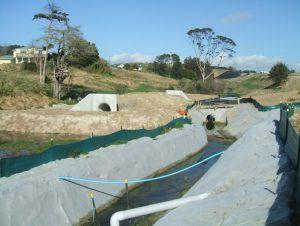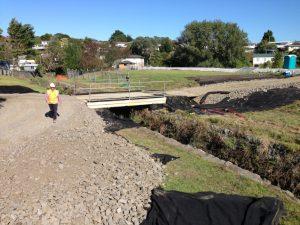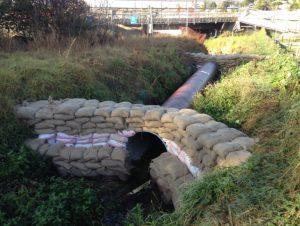Specific Tasks
WaterwaysCrossings (temporary and permanent)
What, why, when and issues to look out for
What
Temporary
If you are installing a temporary crossing, there are a number of options. From an erosion and sediment control point of view, we recommend this order of preference:
- A temporary bridge
- Bottomless arch culvert
- Arch culvert
- Box culvert
- Round culvert
Construction work of the temporary channels should be done off-line, which means in a work area away from the waterflow.
Permanent
If you are installing a permanent crossing, such as a permanent bridge, it must be constructed to all relevant design and regulatory requirements, which are beyond the scope of this toolbox.
Erosion and sediment control measures are usually not constructed in channels with permanent flow, because there is always the risk of a significant storm flow coming from upstream that will greatly reduce their effectiveness.
Why
Temporary watercourse crossings are installed so that construction vehicles can cross waterways without moving sediment into the waterway or directly affecting the streambed.
When
Culverts are the most commonly used type of temporary waterway crossing, and can be easily adapted to most site conditions. However, we recommend using bridges instead of culverts when possible because they obstruct flow and fish migration less, cause little or no modification of the bed or banks, and generally don’t need much maintenance.
Issues to look out for
Bridges
- The available materials and also the site conditions need to be strong enough to bear the expected loadings
- Specific engineering design is required for all bridge structures, permanent or temporary. Bridges can be a safety hazard if they are not designed, installed and maintained appropriately
Culverts

Stabilised clean water diversion and temporary culvert to divert streamflows while a new culvert is being constructed (Source: SouthernSkies).
- Every culvert will be different! For example, some need protection, some have dual flow… They are extremely site-specific. Use the right methods and make sensible adjustments for your site
- Installing and removing culverts causes considerable damage to waterways and can also create the greatest obstruction to flood flows and fish passage
- Even when culverts are temporary, you will need to make sure that fish passage is not impeded in permanent streams. The Department of Conservation’s website provides links to various resources about fish passage.
Design essentials
Culverts and bridges
- You will probably need consent to construct any crossing. The relevant council will consider structural stability, utility and safety of the crossing as well as its erosion and sediment control aspects.
- Plan waterway crossings well before you need them. Construct them during periods of dry weather and outside fish migration seasons (unless different timing is stated in a resource consent condition).
- Choose a location where the potential effects of the crossing (including construction) are minimised.
- Ideally, locate the crossing in a section of the waterway that will be modified as part of the permanent design, eg in a section of stream that may be filled as a result of a new culvert crossing.
- Place control measures between any soil disturbance needed to build the bridge or abutments and the stream channel. The control measures might consist of a super silt fence or bunds that drain to a decanting earth bund (DEB).
- Finish construction as rapidly as possible and stabilise all the disturbed areas immediately during and following construction.
Construction, operation, maintenance and decommissioning
When constructing and operating crossings
Culverts
- For temporary stream crossings, the cross-section of the culvert should be sized for approximately 85% of the channel cross-section. This sizing is important, because stormflows could cause erosion or overtop the culvert causing failure of the temporary access.
- Add scour protection to culverts in case overtopping happens, to ensure the integrity of the crossing and that adverse effects are minimised.
- Consider the overland flowpaths to make sure that larger flows don’t cause excessive safety or environmental impacts. This will typically include confirming that, in larger floods, there is no increase in flood level upstream (up to the 1% AEP storm in flood sensitive areas).
- Divert streamflows when you are installing the temporary culvert, so that you can do the works in dry conditions.
When maintaining and decommissioning crossings
Culverts and bridges
- Inspect temporary waterway crossings after rain for any blockage in the channel, erosion of the banks, channel scour or signs of instability. Repair immediately so that there is no more damage.
- When the structure is no longer needed, remove the structure and all material from the site. Do this is reverse order from how you installed it. For example, divert the streamflows again during removal and while the waterway is being reinstated.
- Keep machinery clear of the waterway while removing the structure.
- Immediately stabilise all areas disturbed during the removal process by revegetation or artificial protection as a short-term control.

